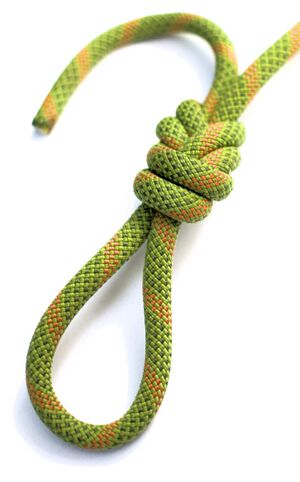Figure eight
The Figure-eight loop is the most used knot for tying-in and one of the two widely accepted knots for tying-in at the end of the rope (the second being the re-threaded bowline).
| Figure eight | |
|---|---|
 | |
| Other names | Figure 8, eight |
| Use(s) | Tying onto the rope end/middle, end-knot (single strand, marking) |
| Pros | Reliable, easy to inspect, low decrease of the rope strength |
| Cons | Tedious to untie after a lead fall in some cases, figure-eight bend is prone to rolling |
| Category | Knot |
| Strength | ~60-80% in normal (non-ring) load. Differs by author, type of measurement and rope[1] |
Tying
Follow-through (tie-in)
This method is the most commonly used method for tying-in onto a rope end.
Steps description: First take a bight of a rope and turn it end around itself making a half of the turn (1), then pull the rope through the upper eye (2) creating a figure-eight knot. Next pull the rope through the both eyes of the harness next to the belay loop (3). Continue by following-through the original figure-eight knot (4,5,6). Next tighten the rope ends (7,8,9,10) and at the end do not forget to check the knot and if the loop is threaded through the harness correctly (11). This step should be done also as a part of the partner check!
On a bight (tie in in a middle)
TODO
Steps description: TODO
Preventing from getting stuck
TODO
Rolling
TODO
References
- ↑ EDELRID Team (20 October 2020). "Strength reduction of textile materials by knots". edelrid. EDELRID GmbH & Co. KG. Retrieved 10 August 2025.